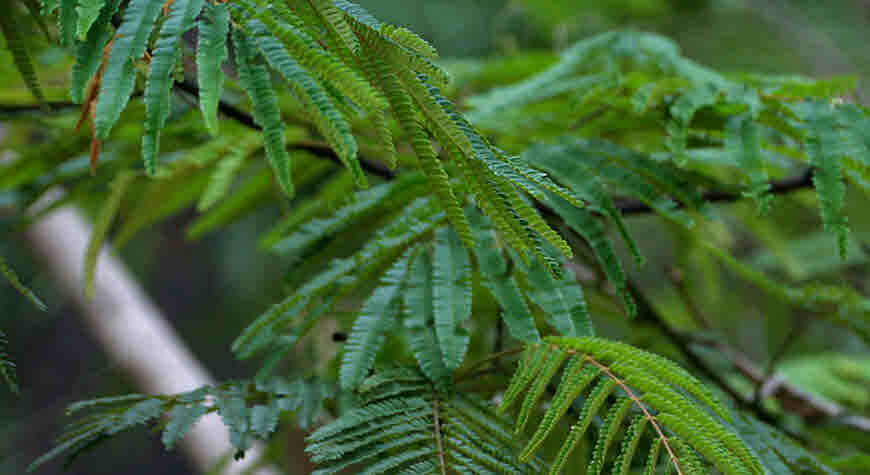Acacia pennata syn. Senegalia pennata (also known as Climbing wattle, and Cha-oum) is a large scrambling or climbing shrub, having numerous prickles. It is native to South, and South-East Asia, and found throughout India up to 1700 meters in the Himalayas. It is a very useful plant with edible leaves.

In India, the plant are used for medicinal purpose in Ayurveda, and Siddha system of medicine. Acacia pennata is known as Aadaari, Ari, Latakhadira in Ayurveda, and Indan, Indu, Iyak Koluntu (tender leaves) in Siddha. The stem, and heart-wood are used for leprosy, haemorrhages, wounds, and Whole plant for coryza, headache, Leucorrhoea, pain, burns, digestive disorders. The bark of the plant are used to pacify aggravated pitta, and treat asthma.
General Information
- Plant Description: Acacia pennata is a scandent shrub with scattered numerous prickles.
- Leaves are bipinnately compound. Pinnas are in 8 to 20 pair, and leaflets are more than 30 pair. Petiole is 2 cm long, with a plate shaped gland near the middle or the base. Rachis is grooved, obscurely prickled, with glands opposite to two uppermost pairs of pinnae.
- Leaflets are 4 to 8 mm long, and 1 mm broad, linear to oblong, tip acute, base truncate, glabrous, margin ciliate, veins obscure, midrib slightly prominent, and very close to the distal margin.
- Legume / Pod is straight, flat, thin, dry, strap-shaped, rounded or shortly apiculate, brown, glabrous, 8- 14-seeded.
- Flowers are white or pale-yellow, in globose pedunculate, heads up to half inch diameter arranged in large terminal panicles.
- Part(s) used for medicinal purpose: Whole Plant, Stem, Heartwood, and leaves
- Plant type / Growth Habit: Large thorny climbing shrub
- Duration: Perennial
- Native/Origin: South-East Asia
- Distribution: Found in the Central, and Eastern Himalayas up to an altitude of 5,000 ft., also in Oudh, Bengal, Bihar, and in Central, Western, South India, and North-Western Himalayas.
- Habitat: In lowland, and medium altitude deciduous bushlands, dry rocky plains
Vernacular names / Synonyms
- Scientific Name: Acacia Pennata (L.) Willd.
- Ayurvedic: Ari Ballikhadira, Khadirapatrika, Sandanika, Silikhadira, Uddala, Lataakhadira
- Bengali: Kuchai, Kuchui
- Dehra Dun: Agia-Bel, Agla, Alay
- English: Climbing Acacia, Climbing Wattle, Feather Acacia, Narrow-Leaved Soap Pod
- Garhwali: Agalai, Agla
- Gujarati: Khervelya, Kherval
- Hindi: Biswal, Latakhadira, Aazi Khair, Aila, Biswul
- Jhunjhunu: Cheela
- Kannada: Siguri, Arar
- Kumauni: Agla, Awal
- Lepcha: Baerzhu, Tol-Rik
- Malayalam: Kattu-Sinikka, Sunna
- Marathi: Aarai Velyakhera, Shemb, Shembati, Shemberti, Shembi, Thembi
- Nepal: Arare, Arfu
- Oriya: Potadontari, Dontari, Nalli-Konti, Pota-Dontari
- Santal: Undar
- Siddha: Indan, Indu, Tender Leaves – Iyak Koluntu
- Tamil: Iya Kozhundu, Indam Budai, Inda Mullu, Indu, Kattindu, Mullu-Chingai, Peychiya-Kai, Singlli, Singai-Mullu
- Telugu: Karusakaya, Korintha
- Thailand: Cha-Om
Scientific Classification
The botanical name of Climbing Acacia is Acacia pennata. It belongs to genus Acacia, and have leaves with small finely divided leaflets which look like feather or fern. The thorns or sharp curved prickles are also present on the branches. Acacia plants bear small globose flowers, and fruits as pods.
Below is given taxonomical classification of the plant.
- Kingdom: Plantae – Plants
- Subkingdom: Tracheobionta – Vascular plants
- Superdivision: Spermatophyta – Seed plants
- Division: Magnoliophyta – Flowering plants
- Class: Magnoliopsida – Dicotyledons
- Subclass: Rosidae
- Order: Fabales
- Family: Fabaceae – Pea family
- Genus: Acacia Mill. – acacia
- Species: Acacia pennata
Synonyms
- Acacia pentagona (Schumach. & Thonn.) Hook. f.
- Mimosa pennata L.
- Senegalia pennata
- Constituents of Acacia pennata
The leaves of the plant contain Octadecadienoic, octadecanoic, palmitic, and pentadecanoic acids; lupeol, a-spinasterol, beta- sitosterol, and tannins.
The bark contains tannin 9%, lupeol, and alpha-spinasterol.
Stem yields sitosterol.
Ayurvedic Properties, and Action of Acacia pennata Leaf
The leaf of Acacia pennata are known as Adari, Khadiravalli, and Ari in Ayurveda, and are used in the treatment of Jvara (Fever), Raktadosha (Disorder of blood), and Agnimandyan (Digestive impairment).
Adari is astringent, bitter, and pungent in taste (Rasa), drying, and light in action (Guna), pungent after digestion (Vipaka), and is cool in effect (Virya).
- Rasa (taste on the tongue): Kashaya (Astringent), Katu (Pungent), Tikta (Bitter)
- Guna (Pharmacological Action): Laghu (Light), Ruksha (Dry)
- Virya (Action): Shita (Cooling)
- Vipaka (transformed state after digestion): Katu (Pungent)
- Action / Karma
- Kasahara: Reduces cough
- Pittashamak: Pacifies Pitta
It is a Sheet Virya herb. Sheet Virya or Cool potency herb, subdues Pitta (Bile), gives nourishment to the body, and steadiness, and supports the building of the body fluids.
Medicinal Uses of Acacia pennata
The bark of the tree is antibilious, and anti-asthmatic. The leaves are stomachic, styptic for Bleeding gum, and antiseptic for scalding of urine.
Asthma
Fresh stem sap is sucked daily once till cure.
Bleeding Gums
In Bleeding from the gums the leaves are chewed with Cumin, and sugar
Body pain, headache, and fever
The decoction of young leaves is taken.
Digestive disorder of infant
The leaf-juice mixed with milk is given to infants who suffer from indigestion with green stools.
Diarrhea
Decoction of stem bark is given orally.
Rheumatism
Extract of root bark is given orally once in a day.
Whooping cough
5-6g of stem bark juice is administered daily twice for five days.
Other Non-Medicinal Uses
- Bark of the tree is used to tan fishing nets in Mumbai.
- The leaves are edible, and used to prepare stir-fries, curry, soups, etc. In Thailand, the tender shoots, and leaves of the plant (Cha-Om) are eaten as salad or cooked vegetable.
- In Myanmar the fruits, and stems are used for poisoning fish.
- Lac is grown on this species in Madhya Pradesh.
The Dosage of Acacia pennata
The recommended dosage of leaves is 20 ml.